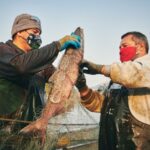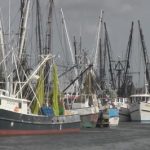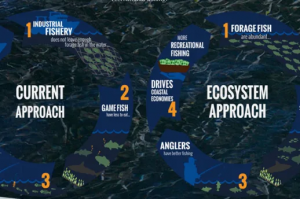Daily Archives: April 7, 2017
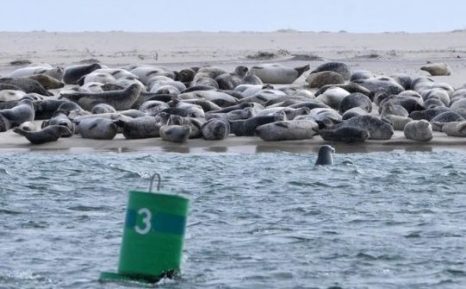
Cape Cod gray seal population estimated at up to 50K
While the first day of the U.S. Marine Mammal Commission’s annual meeting, held for the first time on Cape Cod, dealt with threats to a tiny Mexican porpoise and massive Arctic polar bears, Thursday’s sessions brought the focus home with a profoundly local subject: gray seals. “These animals are reassuming their ecological roles,” said David Johnston, an assistant professor at Duke University. “And people freak out.” Seals are back in force, with between 30,000 and 50,000 living in the waters of Southeastern Massachusetts, primarily on and around Cape Cod, according to a new estimate produced by Johnston to be published in an upcoming report. Feelings about their return, however, are decidedly mixed.,, “They are unprepared that these predators are back in their environment,” Johnston said about people, comparing the gray seal’s historic comeback to that of the reintroduction of the gray wolf in the Western U.S. (I hate these people!) continue reading the story here 19:43
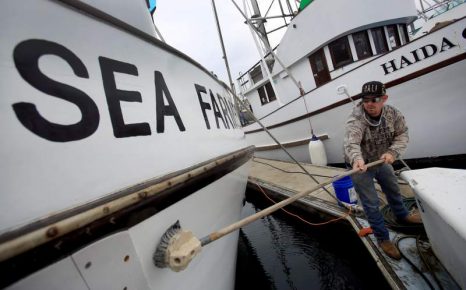
Bleak salmon season awaits commercial fleet as Bodega Bay Fishermen’s Festival returns
Bodega Bay will host its 44th annual Fisherman’s Festival this weekend, celebrating the ocean-going traditions that long supported this coastal village long reliant on its harvest from the sea. The two-day event, capped Sunday by the Blessing of the Fleet, coincides with the historic start of the salmon season, a catch still critical to the community’s prosperity. This year, however, like many in recent memory, commercial anglers on the North Coast await word of just how poor that king salmon harvest is expected to be. “It is bleak,” said veteran fisherman Dave Bitts, president of the Pacific Coast Federation of Fishermen’s Associations. “I’m referring to it as ‘scraps of a season.’” California’s salmon season has been troubled before. But this year the state’s historic drought has exacted what may be its steepest toll, decimating a generation of fish a few years ago in shrunken streams, with far fewer adults now showing up to spawn. Click here to read the story 17:05
Calvert fisherman Laurie Sullivan remembered fondly
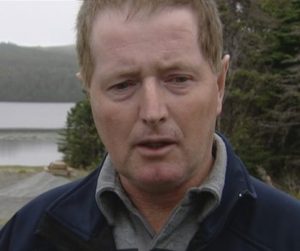 People in Calvert, on the southern shore of Newfoundland’s Avalon Peninsula, are mourning the loss of fisherman Laurie Sullivan, 59, who died Wednesday after he was pulled from the water near the town’s wharf. “It’s such a shock to everybody and his passing has had an impact on everybody,” said Denise Sullivan, a long-time friend and neighbor. Residents of the community say Sullivan was working alone on his boat, the Princess Shaneen, and somehow he ended up in the ocean near it. Like other fishermen in Calvert, he was getting ready to go crab fishing. It was icy at the time, and it’s believed no one saw or heard him fall from the deck. Sadly, continue reading the story here 15:54
People in Calvert, on the southern shore of Newfoundland’s Avalon Peninsula, are mourning the loss of fisherman Laurie Sullivan, 59, who died Wednesday after he was pulled from the water near the town’s wharf. “It’s such a shock to everybody and his passing has had an impact on everybody,” said Denise Sullivan, a long-time friend and neighbor. Residents of the community say Sullivan was working alone on his boat, the Princess Shaneen, and somehow he ended up in the ocean near it. Like other fishermen in Calvert, he was getting ready to go crab fishing. It was icy at the time, and it’s believed no one saw or heard him fall from the deck. Sadly, continue reading the story here 15:54
FISH-NL – A statement on Friday’s protest in St. John’s
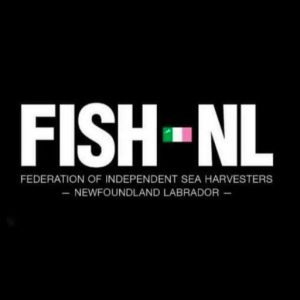 The Federation of Independent Sea Harvesters of Newfoundland and Labrador (FISH-NL) describes the protest Friday at the headquarters of the federal Department of Fisheries and Oceans as a warning of rising unrest within the fishing industry. “Desperate times in the fishery lead to desperate measures,” says Ryan Cleary, President of FISH-NL. “We do not condone violence or civil unrest, but some harvesters around the province are being pushed to the breaking point and have been openly talking about it for months.” “The federal government must realize that the crisis in the fishery today is unprecedented — worse than the groundfish moratoria of the early 1990s — because in most cases harvesters have no other species to turn to.” click here to read the press release 14:20
The Federation of Independent Sea Harvesters of Newfoundland and Labrador (FISH-NL) describes the protest Friday at the headquarters of the federal Department of Fisheries and Oceans as a warning of rising unrest within the fishing industry. “Desperate times in the fishery lead to desperate measures,” says Ryan Cleary, President of FISH-NL. “We do not condone violence or civil unrest, but some harvesters around the province are being pushed to the breaking point and have been openly talking about it for months.” “The federal government must realize that the crisis in the fishery today is unprecedented — worse than the groundfish moratoria of the early 1990s — because in most cases harvesters have no other species to turn to.” click here to read the press release 14:20
Louisiana not ready for early shrimp opener, Shrimp fishermen agree
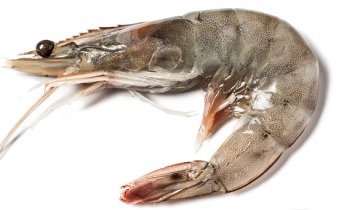 While shrimp conditions are good this year, the Louisiana Department of Wildlife and Fisheries Commission isn’t ready to open the spring season early. Commission members said at their meeting today in Baton Rouge that they want more data before setting the dates for the season. Nearly all of the shrimpers at the meeting said they would rather wait for the season to open at the normal time so the shrimp can grow to be larger. The spring shrimp season usually opens in mid to late May. LDWF biologist Jeff Marx said data he’s collected show better conditions than in previous years. Shrimp size, growth and development generally depend on the amount of rainfall, the temperature and salinity level of the water. But shrimpers spoke against an early season. click here to continue reading the story 13:34
While shrimp conditions are good this year, the Louisiana Department of Wildlife and Fisheries Commission isn’t ready to open the spring season early. Commission members said at their meeting today in Baton Rouge that they want more data before setting the dates for the season. Nearly all of the shrimpers at the meeting said they would rather wait for the season to open at the normal time so the shrimp can grow to be larger. The spring shrimp season usually opens in mid to late May. LDWF biologist Jeff Marx said data he’s collected show better conditions than in previous years. Shrimp size, growth and development generally depend on the amount of rainfall, the temperature and salinity level of the water. But shrimpers spoke against an early season. click here to continue reading the story 13:34
Lawsuit filed seeking $464,000 in lawyer fees, Former fish auction owners renew battle with NOAA
The long and torturous legal battle with NOAA that sent the former Gloucester Fish Exchange  into bankruptcy and to its ultimate sale may not be over just yet. The owners of GFX — the forerunner to the Cape Ann Seafood Exchange on Harbor Loop — are suing NOAA in federal court to recoup about $464,000 in legal fees the company paid during its battle and ultimate settlement with the federal fisheries regulator. The action names current Commerce Secretary Wilbur Ross, the Commerce Department and the National Oceanic and Atmospheric Administration as defendants. The suit, prompted by NOAA’s final decision on March 6 denying GFX any reimbursement for legal fees, rekindles the battle that began as far back as 2005. The long-running affair resulted in two NOAA enforcement actions against the former auction — and a subsequent apology by then Commerce Secretary Gary Locke and NOAA administrator Jane Lubchenco for the excesses of the agency’s law enforcement unit. Click here to continue reading the story 13:07
into bankruptcy and to its ultimate sale may not be over just yet. The owners of GFX — the forerunner to the Cape Ann Seafood Exchange on Harbor Loop — are suing NOAA in federal court to recoup about $464,000 in legal fees the company paid during its battle and ultimate settlement with the federal fisheries regulator. The action names current Commerce Secretary Wilbur Ross, the Commerce Department and the National Oceanic and Atmospheric Administration as defendants. The suit, prompted by NOAA’s final decision on March 6 denying GFX any reimbursement for legal fees, rekindles the battle that began as far back as 2005. The long-running affair resulted in two NOAA enforcement actions against the former auction — and a subsequent apology by then Commerce Secretary Gary Locke and NOAA administrator Jane Lubchenco for the excesses of the agency’s law enforcement unit. Click here to continue reading the story 13:07
Western rock lobster price falls due to a drop in China demand, cheaper American exports
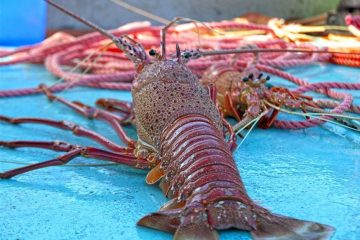 The value of premium species of lobster sourced from Western Australia has plummeted, causing the lucrative industry to grind to a near halt. The western rock lobster ‘beach price’, which is the price professional fishers receive direct from processors, has slumped to about $50 a kilogram. Compared to six months ago, the price has shed about 30 per cent of its value. Mark Rutter is the general manager of marketing and business development at the Geraldton Fishermen’s Co-operative, which is the largest processor and exporter of rock lobsters in Australia. “It’s very hard to pinpoint exactly what’s driving the prices but certainly we are experiencing very low prices … in a recent historical sense,” he said. continue reading the story here 11:36
The value of premium species of lobster sourced from Western Australia has plummeted, causing the lucrative industry to grind to a near halt. The western rock lobster ‘beach price’, which is the price professional fishers receive direct from processors, has slumped to about $50 a kilogram. Compared to six months ago, the price has shed about 30 per cent of its value. Mark Rutter is the general manager of marketing and business development at the Geraldton Fishermen’s Co-operative, which is the largest processor and exporter of rock lobsters in Australia. “It’s very hard to pinpoint exactly what’s driving the prices but certainly we are experiencing very low prices … in a recent historical sense,” he said. continue reading the story here 11:36

Updated – Protesters smash window, occupy DFO building in St. John’s over shrimp quota cuts
Police were called Friday as members of the Newfoundland and Labrador Independent Fish Harvesters’ Association protested at Fisheries and Oceans Canada headquarters in St. John’s, pushing their way into the building. Around 50 protesters went inside the federal building on White Hills Road, to protest against new quota cuts for the province’s inshore shrimp fishery. CBC has learned that employees are being asked to secure themselves in their offices. By 10 a.m., a window had been broken at the facility, moments after CBC recorded a video of a man kicking the window. RNC officers were on the scene by 10:30 a.m., as protesters entered the cafeteria in the building, and were meeting officials of the department Click here to read the story 11:15

Montauk 1915: When the Village Was on the Arc of Fort Pond Bay
The wooden shacks composing this village had all been built around 1895 by people who did not own this land. They were squatters on this arc of the bay on land owned by the Long Island Rail Road. The railroad did not stop this village from being built. In fact, they encouraged it. Probably it was because money changed hands between these people and the railroad. The people were commercial fishermen and their families. And they brought in tons of fish from the sea to that single pier and paid for the railroad trains nearby to transport their daily haul of fish to the thriving markets in New York City.,, These fishermen were not even Americans. They were Canadians. They were out of port towns in Nova Scotia, a long way from home, and they had full holds of fish to bring to market. And here, along the arc of this bay, was this nearly abandoned railroad station in the middle of nowhere. There was even a long pier. They’d tie up and meet the stationmaster there. Yes, the tracks led 110 miles straight into Manhattan. A very interesting read! click here to read the story, and click the link to the Pelican The Single Worst Fishing Disaster in the History of Montauk 09:40

Fishers blocks access to DFO building in St. John’s
Members of the Newfoundland and Labrador Independent Fish Harvesters’ Association were outside Fisheries and Oceans Canada headquarters Friday morning. They’re blocking employees from entering the federal building on White Hills Road, to protest against new quota cuts for the province’s inshore shrimp fishery. The fishermen are outraged by lower quotas for the inshore shrimp fishery off the northeast coast of Newfoundland. The new quota for a fishing zone known as Area 6 will be just 10,400 tonnes, less than a quarter of the 2015 quota of 48,196 tonnes. Last year’s quota had been set at just under 28,000 tonnes. click here to read the story 08:56


































